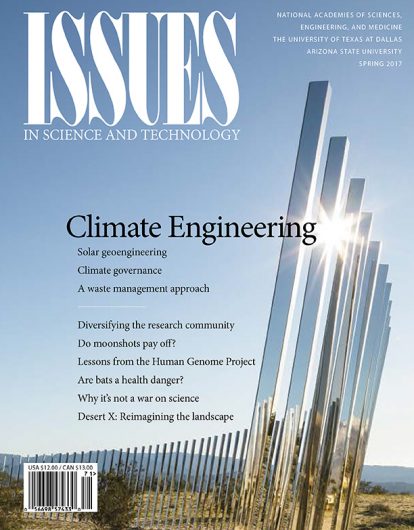CSPO News
Spring 2017 Issues in Science and Technology
The latest "Issues" looks at climate engineering, big science projects, diversifying the research community, and more.
The Spring 2017 Issues in Science and Technology features a special editorial package on climate engineering. The authors of these three articles believe that the seriousness of the risks posed by a warming climate means that it’s time to take a hard look at all available options for addressing the problem, including directly intervening in the climate. A leading researcher in geoengineering, Harvard University’s David Keith, outlines a responsible research agenda for solar geoengineering. Jane C. S. Long, the former associate director for energy and environment at Lawrence Livermore National Laboratory, describes a systems approach to climate change, beginning with limiting greenhouse gas emissions and adapting to unavoidable climate disruptions, while researching the feasibility of geoengineering. And, in a refreshingly direct approach to the climate issue, Arizona State University’s Klaus Lackner and Carbon A List founder Christophe Jospe ask why we don’t treat carbon dioxide emissions like other forms of waste. Direct carbon capture may offer a pragmatic way to deal with greenhouse gases.
Intervening in the climate system would be an unparalleled example of “big science.” David J. Galas, Aristides Patrinos, and Charles DeLisi examine lessons offered by a previous big science effort that almost didn’t happen—the Human Genome Project (HGP). The Department of Energy, surprisingly, was the birthplace of the project to map the human genome, and the authors all served central roles at the agency during the initiation and operation of the HGP. They describe the need for a rigorous process to evaluate large-scale research proposals. Consortium for Science, Policy & Outcomes senior fellow Walter D. Valdivia looks at scientific “moonshots” to assess the value of rapid increases in federal support for specific areas of R&D.
Also in this issue, the president of the University of Maryland, Baltimore County, Freeman H. Hrabowski III, and his senior advisor Peter H. Henderson explore how a forward-looking group of colleges and universities are demonstrating effective ways to educate underrepresented minorities for careers in science and engineering. Long-time bat researcher and advocate Merlin Tuttle explains why scientific studies of bats as vectors for viruses are unlikely to contribute substantially to human health, and may threaten the future of bats.
Our Perspectives section includes a fascinating take on how increasingly complex algorithms are changing science from Ed Finn, author of What Algorithms Want: Imagination in the Age of Computing. Clark Miller explores the populist revolt against big government, arguing that it doesn’t constitute a war on science. And philosopher Steve Fuller looks at an odd confluence of science and politics: the presidential ambitions of Zoltan Istvan, 2016 candidate for the Transhumanist Party.
In our Spring book review section, we’re excited to run a review essay by the new chancellor of the University of California Berkeley, Carol Christ. She evaluates a number of books that explore how new technologies are changing the modern university and helping to confront issues of accessibility, affordability, and quality. William Lanouette, who wrote the definitive biography of Manhattan Project physicist Leo Szilard, reviews the new biography of another Manhattan Project scientist, Enrico Fermi. Lanouette describes The Pope of Physics: Enrico Fermi and the Birth of the Atomic Age as “a dramatic narrative” that “brims with colorful details and instructive explanations.”
This issue also features artwork from the Desert X exhibit in California’s Coachella Valley, and beautiful glass sculptures of human viruses by Luke Jerram.
